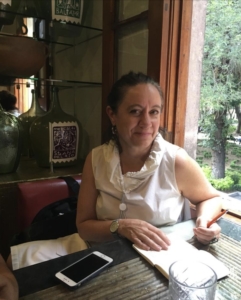Brochure Births
Gaby left her hometown of Guadalupe y Calvo in Mexico’s northern Chihuahua to become a midwife. I don’t know whether she was more interested in delivering babies or simply staying alive. Perhaps she doesn’t either. She told me her story over lunch in Parral after a birth preparation class she gave at one of Mexico’s few midwife-run clinics. As she spoke, I filled the binder in my mind with as many details as it could handle, knowing it could never be enough.
As I write about midwifery, I have become obsessed with precision. I can’t rely on my treacherous mind. I fact check my fact checking, footnote everything, compile folders of pdfs: Health Ministry meetings on decreasing the number of cesarean sections—of which Mexico has the third highest in the world; bills to reform health laws so hospitals and clinics can hire midwives; links to articles and OpEds on how midwives improve maternal health; small town headlines of women giving birth in public places when doctors are too busy to attend them. If I just dig deep enough, I think, I will find the exact precise information that will help me understand how we got to this situation where midwives—midwives!—are misunderstood and ostracized and offered no training, no work, and no respect from the health system.
And though she is optimistic about her work, Gaby can’t help but weave into her words the ever-present threat to life in towns where narcos spill across artificial boundaries like the state border lines that pretend to separate Chihuahua from Sinaloa from Durango. Those imaginary lines converge upon Guadalupe y Calvo at the heart of Mexico’s Triángulo Dorado, the hard-to-reach mountainous area lush with weed and poppies. On Google Maps I find the twisty, turney road from where we met in Parral to the home where her husband and baby still live. Five hours of driving cover a mere 250 kilometers: fifty kilometers in an hour. Thirty miles. What does that look like, I wonder: beautiful, green, and muddy, like the pictures I’ve seen of Badiraguato, El Chapo’s hometown?
I use Google Earth to peek at that remote reality. The streets of Guadalupe y Calvo have shaved the mountainside of the surrounding shrubs and pines, its rough tan dust vivid enough to settle on my keyboard. In the cragged outline of the town, a red pin marked H shows the Hospital General where the older nurses urged Gaby to leave town, speaking with her as they cared for yet another woman who had made it to them beaten and raped.
I’ve become inured to the grisliness of birth—c-section gashes and yellow layers of fat, screaming gray babies, meconium, amorphous iron-red placentas. Will numbness find me too with the violence? The hanging bodies, the incomplete remains, the pockmarked trucks, the burned homes? These are the things we don’t talk about, that lurk behind stories of shimmering, happy births, the enviable births, the brochure births of bright-eyed women, foreheads free of sweat. But life is more complicated; it brings us unwanted babies, impossible abortions, terrifying births, brutal men. This is the world, my world, Gaby’s world. It is neither one of Disney fantasies nor Blumhouse horror shows, but somewhere in between.
The internet only takes one so far. In Parral, I ask to drive by the small concrete building that houses the newspaper El Monitor de Parral,whose interior was effaced days earlier by Molotov bombs. Dozens of outlets across the country covered the news. Editors showed their solidarity by reporting on the attacks—not because attacks were new, but because they weren’t. In EntreLíneas, I read of four disappeared men who were found alive in Guadalupe y Calvo, and another four—supposedly Sinaloa Cartel kidnappers—who were rescued from the hands of justice by armed men that ambushed the police headquarters. Chihuahua rivals Sinaloa and Tamaulipas for the highest number of disappeared, but it happens elsewhere, too. I search for the 2017 Law on Disappearances and come across a Colombian Prezzi that looks just like Mexico’s mess but came years before. I find relief that some sites cover “imagenes fuertes” with large red warnings. And though the Blog del Narco has tempered its zeal after its anonymous founder received threats, I will never forget the missing faces of the murdered I saw years ago—a haunting precision too hard to shake.
I pull myself out of the daze of the Golden Triangle and return to the midwifery school in Guanajuato where Gaby bunked with ten other women from around the country, studied from her bible-sized Varney’s Midwifery, and learned to give presentations like the one I saw in Parral. I remember the ice cream Percherón on San Miguel’s plaza and imagine the midwifery students on the benches of this UNESCO World Heritage Site, so far from Guadalupe y Calvo and the other places they’ve come from, some surely happy, some surely nostalgic for home.
I explore what happens at the outer edges of life — before life begins when we find ourselves dealing with the messiness of pregnancies whether we want them or not; the solidarity we can find in midwives who often work within authoritarian health systems, and among activists promoting birth justice. Recently I spend more time thinking about the end of life too, about the importance of closure, and, in the extreme cases of contemporary Mexico, of reuniting the unknown dead with the families who are looking for them. I live in Mexico City, work on a UN team for human identification, and am highly prone to midnight snacks.





